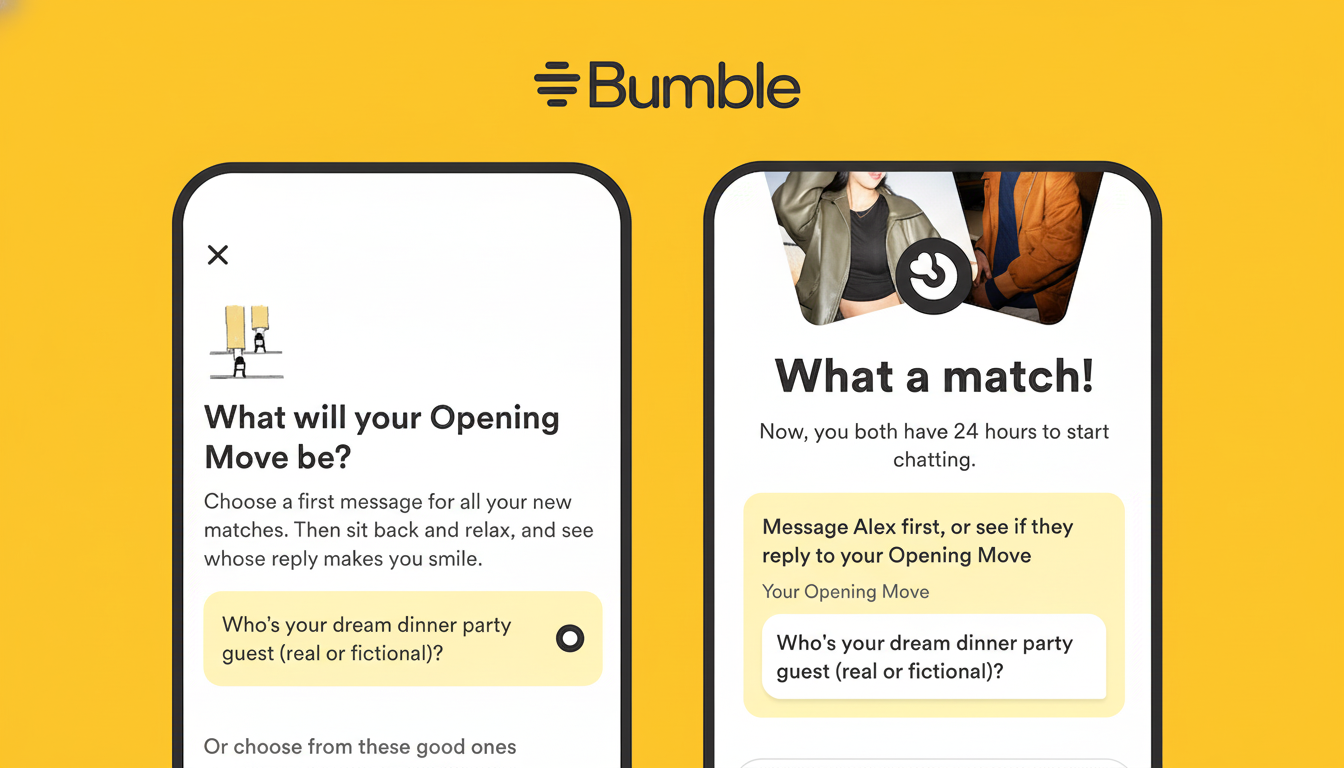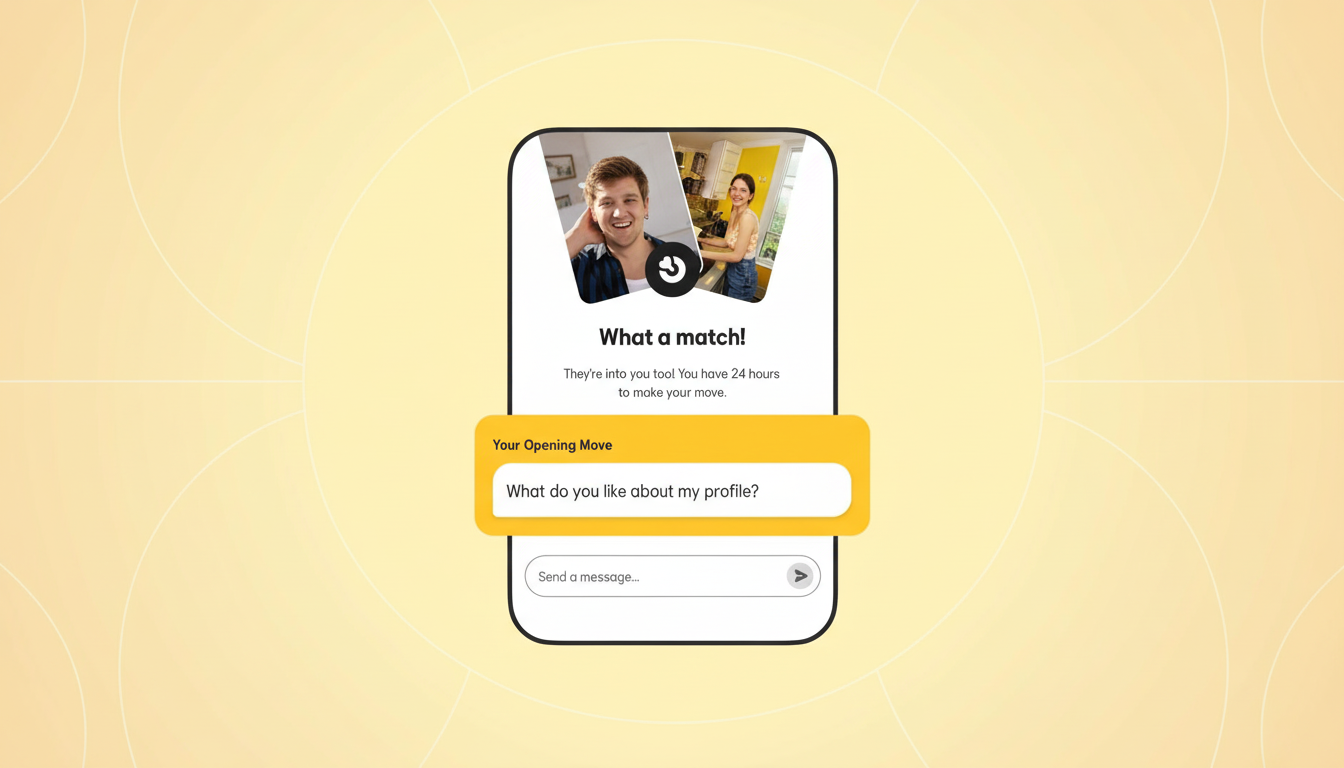Bumble has quietly changed the way first messages work — it has expanded its Opening Moves tool so matches can get in touch with a little more context. Here’s a field guide to how things have changed and what to expect when you fire up the app in your new baggy sweatpants for some virtual companionship.
How Bumble works today, from swipes to matches
Bumble is a swipe-based dating app: you build a profile, set filters, and then swipe right to like or left to pass. Matching occurs when both users swipe right and the “It’s a match!” alert appears. On heterosexual matches, Bumble has traditionally required women to be the first to reach out; Opening Moves replaces that signature rule with mechanisms for users to jump-start conversations.
- How Bumble works today, from swipes to matches
- Find people and manage messages in People and Discover
- Opening Moves explained: prompts that start chats
- Is Bumble free, and what do paid levels add to value?
- How to get better matches on Bumble with simple tweaks
- Safety and privacy features worth turning on in Bumble
- What the data says about dating apps and their users
- Bottom line: use Opening Moves and polish your profile

Setup is easy: Add four to six photos (the company recommends this for best results), fill out basics such as age, height, and location, then add some information about dating intentions and interests before filtering out who you’re looking for. “The more information you share, the better we’ll be able to surface potential matches that have similar attitudes toward financial planning.”
Find people and manage messages in People and Discover
On the People tab, you’ll be swiping through the main stack. The Discover tab showcases a small selection of curated profiles that the algorithm thinks you will like and updates every morning. When you’ve both liked each other, a match is created and you can start exchanging messages; paid members can also see who has liked them before they have matched.
There’s a clock: You have 24 hours before the match expires if nobody messages. Free users are allowed to extend one match per day; subscribers can extend as many matches as they like, or even resurrect them.
Opening Moves explained: prompts that start chats
Opening Moves allows users to add up to three prompts on their profile that a match can respond to in order to start a chat. It’s like a guided icebreaker that eliminates “hey” messages and gets you to feel something from the jump. They will then respond to one of the prompts in a 400-to-650-word essay. Examples include “What’s an overrated travel tip?” or “Two truths and a lie.”
The practical shift: Where women-first messaging was a stridently feminist statement on Bumble in heterosexual matches, Opening Moves provides a structured space for all users to lead with a response to a prompt. In these chats, someone has to send at least one message for the conversation not to disappear.
Is Bumble free, and what do paid levels add to value?
Bumble’s essential experience — swiping, matching, and messaging — is free. Subscriptions come with convenience as well as visibility benefits. The product comes in three levels: Boost, Premium, and Premium+. Prices are subject to change and vary by market, though Bumble has said users can expect to pay around $32.99 per week for premium plans purchased weekly, and there are longer-term options available as well.
Boost gives unlimited swipes, a 24-hour flurry of unlimited matches that you can share with your potential matches, and the ability to rematch with expired connections. Backtracking — which lets you change your mind if you swiped left on a particular profile (though it’s really just an endless supply of “noes”) — is included in Boost. Spotlight places your profile at the top of others’ feeds for 30 minutes. A handful of SuperSwipes is also part of the suite.
Premium adds everything in Boost, plus the ability to see who has liked you beforehand, add more advanced filters on your profile, use Travel Mode so that you can appear somewhere else, access Incognito Mode where you’ll only be seen by people you like or message first, and get a regular weekly Spotlight.
Premium+ comes with extra weekly SuperSwipes, a limited number of Compliments to send with a like, more Spotlights, and profile performance analytics so you can assess what’s working.
How to get better matches on Bumble with simple tweaks
Include a few images with varied angles, as well as both head and full-body shots.

Flesh out your bio with specifics about what you’re looking for, interests, intentions, and nonnegotiables — they can help the algorithm help you (and other people). Set a few advanced filters to narrow the pool without overfitting; overly strict guidance can limit your scope.
Lean into Opening Moves. Choose prompts that lead to stories, not one-word answers. If you’re hesitant to open with small talk, prompts will do the heavy lifting for you by offering a natural first question on which to build.
Time matters. Give your profile an airing every few weeks, careerist style: Update it regularly with new photos and a rewritten bio. Many apps will make new profiles more visible for a short time. Use Spotlight when you can get back to them — attention is only beneficial if it’s returned.
Safety and privacy features worth turning on in Bumble
Bumble has photo verification tools, but it’s always better when you feel safe and don’t have to use them in the first place.
Other features include easy in-chat blocks and reporting, as well as the new Incognito Mode for more privacy — and rewinding if you swipe on a person when you meant to swipe left. Safety is a value the company has strongly focused on since launch; these tools are worth activating, particularly if you’re in a smaller community or take lots of trips.
What the data says about dating apps and their users
About 30 percent of never-married Americans have used an app or site, along with a third of widowed or divorced adults (far fewer older people who are married or in long-term relationships have ever done so). And the youngest adults are the most likely to have done so. (As others tell it, there’s evidence that younger men, too — and perhaps particularly among young men — increasingly find “pornography as exciting as sex.”)
And certainly there are, it seems to me, benefits to accompanying sexual liberation and salacious overexposure: greater acceptance for all of us, across sexual orientations and gender identification; less social isolation for those looking exclusively in virtual spaces; more opportunities even in rural America for those seeking their first partner.
But don’t forget this other truth: While some level of online dating has become widespread throughout personal life — about one-third of all married couples today say they first met online — I think women were doing just fine without these apps and sites. Close to half had met face-to-face; getting introduced on airplanes existed long before 9/11 made travel stricken by paranoia… We’re managing domestic violence better than we did when I was growing up last century, but at least some measure would be getting better now no matter what toward putting a stop to that signature male oath-secrecy-retaliation combo noted above.
There are millions of paying users for dozens of dating apps, indicating that subscription features have become another way to attract customers in a crowded market of companies seeking to cater to people who date frequently (and have the means to pay for it) or those who don’t want multiple options clogging their screens.
Bottom line: use Opening Moves and polish your profile
Bumble still operates on mutual likes, fast-paced chats, and a culture that encourages women to make the first move — even when it comes to finding friends. Now that Opening Moves is broadening, the app delivers better conversation starters and a change in who gets to speak first — take advantage of those tools, give your profile a bit more polish, and you’ll aim the odds in your favor.

